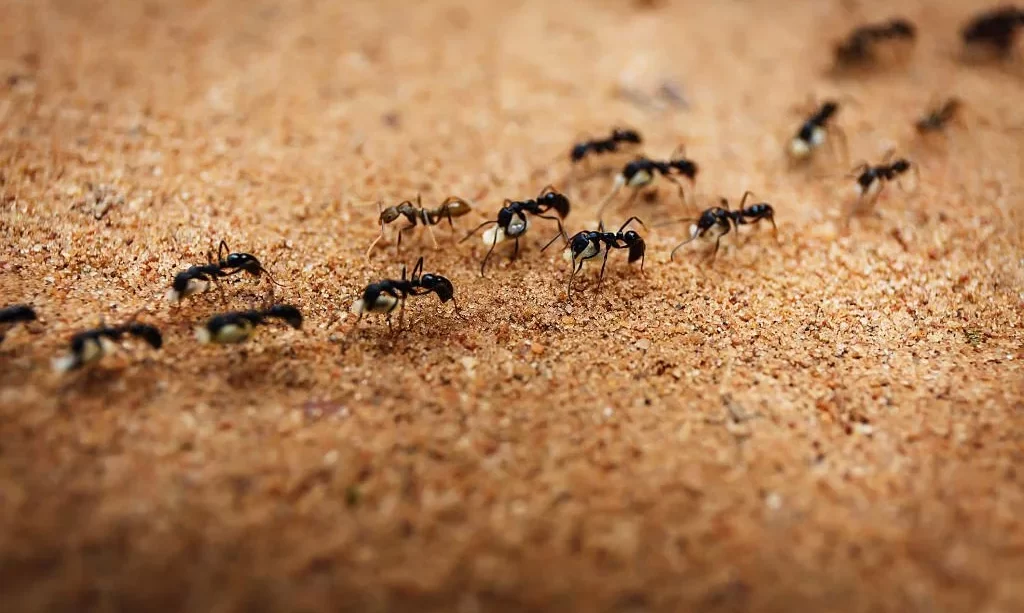A sandbox is a cherished space for children, where they can unleash their creativity, build imaginative worlds, and engage in outdoor play. However, this beloved play area can sometimes become a target for unwanted guests – ants. Ants in a sandbox not only disrupt play but can also pose health concerns. In this comprehensive guide, we will explore effective methods to ensure that your sandbox remains an ant-free zone, allowing your children to enjoy hours of carefree play. We’ll start by discussing the critical aspects of sandbox placement and preparation, setting the foundation for a safe and enjoyable play environment.
- Attracts & Kills – Kills common household ants including acrobat, crazy, ghost, little black, odorous house, pavement, and other sweet-eating ants
- Kills the Ants You See & the Ones You Don’t – As worker ants discover the bait, they share it with the rest of the colony to eliminate them all
- Works Fast – You should see a significant decrease in the number of ants visiting the bait stations within just a few days
- Ready to Use – Place the bait stations, watch it attract ants, and eliminate the entire colony
- Use Throughout Your Home – Place stations near areas where you’ve seen ant activity including along baseboards, in corners, on counters, and more
Sandbox Placement and Preparation
The first step in safeguarding your sandbox against ant invasions is carefully selecting its location and preparing the area. Here’s what you need to consider:
- Choosing the Right Location: Opt for a location that receives ample sunlight throughout the day. Sunlight helps to keep the sandbox dry and discourages ants, which tend to prefer shaded, damp areas. Ensure that the chosen spot is away from trees, bushes, or overhanging branches, as ants can drop into the sandbox from above.
- Use Weed Barrier Fabric: Before filling the sandbox with sand, lay down weed barrier fabric. This fabric not only prevents weeds from growing up into the sandbox but also acts as a deterrent to ants burrowing in from below. Secure the fabric along the edges to prevent any gaps.
- Proper Drainage: Ensure that the sandbox area has proper drainage. If rainwater accumulates in or around the sandbox, it can create ideal conditions for ant nests. Consider installing a slight slope away from the sandbox to encourage water runoff.
- Regular Inspection: Establish a routine for inspecting the sandbox and its surroundings. Regularly check for ant mounds or signs of ant activity in nearby areas. Early detection allows for prompt intervention before ant infestations become severe.
By thoughtfully selecting the sandbox’s location and taking preparatory measures, you can create a less hospitable environment for ants and set the stage for a secure and enjoyable play space for your children.
Regular Sandbox Maintenance
Maintaining your sandbox is crucial to keep ants at bay and ensure a safe play area for children. Here are essential steps for regular sandbox maintenance:
- Remove Debris: Encourage children to clean up after play by removing toys, shovels, and buckets from the sandbox. Leftover food crumbs, spilled drinks, or forgotten toys can attract ants.
- Rake the Sand: Periodically, rake the sand to break up compacted areas and promote even drying. This prevents moisture retention that may attract ants. Make it a fun activity involving your kids to instill good habits.
- Cover When Not in Use: Cover the sandbox with a fitted lid or tarp when it’s not in use. This prevents not only ants but also other pests like cats from using the sandbox as their playground or litter box.
- Regularly Check for Ants: During your routine inspections, watch for any signs of ant activity. If you spot ant mounds nearby, take action promptly to eliminate the colonies before they reach the sandbox.
Natural Ant Repellents
Natural repellents can be effective in deterring ants from your sandbox without the use of chemicals. Here are some natural ant repellents to consider:
- Cinnamon: Sprinkle ground cinnamon around the perimeter of the sandbox. Ants dislike the scent of cinnamon and will avoid crossing it.
- Baby Powder: Baby powder can serve as a natural ant barrier. Sprinkle it liberally around the sandbox’s edges to create a boundary that ants are reluctant to cross.
- Diatomaceous Earth: Diatomaceous earth is a non-toxic, powdery substance that can be scattered around the sandbox. It works by dehydrating ants and other insects, making it an effective natural repellent.
Homemade Ant Traps
Creating homemade ant traps can help control ant populations around the sandbox. Here are two simple recipes:
- Borax and Sugar Trap:
- Mix equal parts borax and powdered sugar.
- Place small containers, like jar lids, near the sandbox filled with this mixture.
- The sugar attracts ants, and the borax is toxic to them. They will carry it back to the nest, ultimately eliminating the colony.
- Vinegar and Water Trap:
- Combine equal parts white vinegar and water in a shallow container.
- Place these vinegar traps near ant activity hotspots or along the sandbox border.
- The strong scent of vinegar repels ants, discouraging them from approaching the sandbox.
Remember to place these traps strategically and out of reach of children to ensure their safety. These homemade ant traps offer an eco-friendly and child-friendly way to combat ant infestations in and around your sandbox.
Store Sandbox Toys and Accessories Properly
Proper storage of sandbox toys and accessories is an often-overlooked aspect of ant prevention. Follow these guidelines to keep your sandbox area tidy and unattractive to ants:
- Covered Containers: Invest in covered containers or bins specifically designated for sandbox toys. These containers keep toys clean and dry while preventing ants from using them as hiding spots or nesting areas.
- Clean-Up Routine: Teach children to clean and return toys to their designated containers after each sandbox play session. Encourage good habits of cleanliness and responsibility for their play area.
- Inspect Containers: Regularly check the toy containers for signs of ant activity. If you notice ants inside or around the containers, take prompt action to remove them and prevent further infestation.
Regularly Check and Treat Ant Mounds
Ant mounds in close proximity to your sandbox can be a cause for concern. Here’s how to monitor and address them:
- Routine Inspection: As part of your regular sandbox maintenance, keep an eye on the sandbox’s surroundings for ant mounds. Ant colonies often build nests in nearby grassy areas, so pay attention to the grass bordering the sandbox.
- Ant Baits: Use ant baits strategically placed near ant mounds or along ant trails. Ant baits are designed to attract ants, which then carry the bait back to the colony, effectively eliminating it. Follow the manufacturer’s instructions for safe and effective use.
- Natural Remedies: If you prefer natural solutions, consider pouring boiling water into ant mounds. This can be an effective way to destroy ant colonies without resorting to chemical treatments. Exercise caution when using hot water, and avoid contact with children and pets.
- Ortho Orthene Fire Ant Killer1 kills the queen, destroys the mound and treats up to 162 mounds
- This fire ant killer begins killing in just 60 minutes so you can get back to enjoying your yard fast
- Kill fire ants outdoors on your lawn and around ornamental plants, including flowers, trees and shrubs
- To treat fire ant mounds, simply sprinkle the product over each mound using amount specified on the product label, no watering-in needed
- This pack includes two 12 oz. bottles of Ortho Orthene Fire Ant Killer1; for best results, use as part of the Ortho 2-Step System with Ortho Fire Ant Killer Broadcast Granules (sold separately)
Encourage Proper Sandbox Play
Promoting proper sandbox play habits is key to preventing ant infestations:
- No Food or Drinks: Emphasize that food and drinks should not be brought into the sandbox. Crumbs and spills can attract ants and other pests. Instead, encourage children to enjoy snacks away from the play area.
- Hygiene After Play: Teach children to wash their hands thoroughly after playing in the sandbox. This practice not only prevents the spread of germs but also helps remove any residual odors that might attract ants.
- Adult Supervision: Supervision is essential, especially for younger children. Adults can ensure that proper hygiene and play guidelines are followed and can promptly address any ant-related concerns.
Conclusion
An ant-free sandbox is essential for providing a safe and enjoyable play space for children. By diligently storing sandbox toys, regularly inspecting and treating ant mounds, and fostering proper play habits, you can maintain a clean and pest-free sandbox environment. Remember that consistent maintenance and responsible play are the keys to a thriving and ant-free sandbox where children can create lasting memories and have endless fun.





